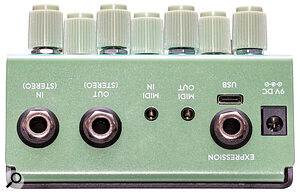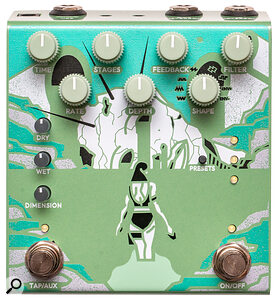Old Blood Noise Endeavours (OBNE) describe the Bathing as a ‘liminal’ delay — a word I had to look up before writing this review! In this context, apparently it means something like ‘at the edge, in between, or in transition’ and that fits well, because the Bathing isn’t quite delay, reverb, or phaser — rather, it straddles the boundaries between them, with the modulation capabilities building on the delay, flanger and phaser ideas explored in OBNE’s Dweller pedal.
The pedal itself is solidly‑engineered, and boasts 10 knobs — more than most pedals — plus a pair of ‘soft touch’ momentary action footswitches (Tap/Aux and On/Off). The in and out jacks are unbalanced TRS types, and can accept mono or stereo connections, plus there’s an expression pedal jack, a USB‑C port and MIDI in and out on TRS mini‑jacks.
At the Bathing’s core is a delay line that’s routed through multiple all‑pass filter stages (while an all‑pass filter passes all frequencies with equal gain, it alters the phase relationship between them), to generate dynamic, evolving repeats. The Time control sets the central delay time, which can also be tapped in using the Tap footswitch (with six tempo subdivisions), or sync’ed to MIDI Clock. You can also press Tap/Aux while turning the Time knob to select the timing subdivisions. The Stages knob determines how many all‑pass filters the signal passes through (from two up to 12), with more stages increasing the complexity, resulting in a more dense, ‘chattering’ repeat at longer times. Feedback performs the usual function of recirculating the delays to create a longer decay tail, but note that the Filter and LFO controls also affect the fed back signal, so that the repeats shift in character. The filter is dynamic, affecting both the tone and density of repeats, with a range from dark and warm to thin and bright.
The LFO has controls for Rate, Depth, and Shape. At short delay times, adding modulation creates effects reminiscent of flanging or chorus, while at longer delay times, it adds anything from just one repeat up to a shower of scattered echoes, which are also affected by the Filter control. If stereo output is enabled, the left and right LFOs are offset to produce a stereo effect. Shape cycles smoothly through Sine, Triangle, Square, Ramp Up, Ramp Down, Random, and two Envelope LFO modes. Depending on the Rate and Depth settings, a wide range of less obvious effects are conjured up, and at longer delay times the effect moves anywhere from a single repeat to a scattering of many diffuse repeats. At short delay times, you can get more recognisably familiar modulation effects but with added texture and movement when compared with conventional modulation effects.
 Small Dry and Wet volume controls are augmented by an equally small Dimension control that adds stereo modulation to the wet signal, but also adds a sense of ‘thickness’ in mono. To save your own endeavours with the pedal, there are three onboard presets accessible from the front panel, and up to 127 presets can be saved and recalled using MIDI. Trails can be toggled on or off globally, so if trails are not needed a true bypass is available.
Small Dry and Wet volume controls are augmented by an equally small Dimension control that adds stereo modulation to the wet signal, but also adds a sense of ‘thickness’ in mono. To save your own endeavours with the pedal, there are three onboard presets accessible from the front panel, and up to 127 presets can be saved and recalled using MIDI. Trails can be toggled on or off globally, so if trails are not needed a true bypass is available.
Why ‘Bathing’? Well, if the sounds on offer have something in common it is their fluid quality, and that probably inspired the pedal’s name. While the Bathing can create a host of unusual delay sounds that sit somewhere between multi‑tap delay, reverb, modulation and almost granular characteristics, adding an expression pedal takes things further, as any combination of knobs can be mapped to an expression pedal — the user sets the heel and toe values for each parameter using the pedal itself. If you don’t need that feature, a footswitch such as OBNE’s Scooch can provide tap tempo or momentary feedback ramping. MIDI users get access to full CC control over every parameter, MIDI Clock sync and PC‑based preset switching.
Experiment with the modulation and you have a real sonic playground.
Verdict
The Bathing is such an unusual pedal that it’s tricky to pigeonhole it, but the words ‘organic’ and ‘complex’ spring to mind, and it would be fair to say that it will probably appeal most to the more experimental musicians out there; it could easily find a place as part of an ambient pedalboard rig. Its effects can range from textural modulations to multi‑tap ‘delay meets reverb’, and the Filter control can either turn the added sprinkles of delay into glittery wave crests or a subdued undertow. Max out the feedback and the sound hangs around for ages, and that can be useful in creating drones and washes. Experiment with the modulation and you have a real sonic playground. The pedal works perfectly well when run in a mono setup, but it’s definitely worth running in stereo if you have a stereo rig for live use, or when you’re recording.
If you’re looking for a straight emulation of a tape echo, then, this pedal might be considered overkill. But if you like ambient textures and are looking for something that goes way beyond the usual delays, reverbs and modulation effects, it could be just what you need to take your sonic explorations in a new direction. Even before you know how all the controls interact, a bit of experimental twiddling invariably comes up with something useful. The Bathing liminal delay pedal works just as well with keyboards as it does on guitar, and although the sounds it produces can sometimes seem chaotic, in my experience they almost always remain musically valid. There’s a lot to explore here that you won’t find in other pedals.
Information
When you purchase via links on our site, SOS may earn an affiliate commission. More info...


